Main menu
Common skin conditions

NEWS
Join DermNet PRO
Read more
Quick links
Diffuse hereditary palmoplantar keratodermas — extra information
Diffuse hereditary palmoplantar keratodermas
Author: Dr Amy Stanway, Dermatology Registrar, Nottingham, United Kingdom, 2005. Update December 2020
What are diffuse hereditary palmoplantar keratodermas?
Diffuse hereditary palmoplantar keratodermas are the palmoplantar keratodermas that diffusely involve most of the palm and sole and are caused by a genetic abnormality. Several family members may be affected. Some types of syndromic keratoderma are associated with abnormalities of internal organs.
They may be inherited from one affected parent (autosomal dominant inheritance) or from both parents, who are generally unaffected (autosomal recessive inheritance). The responsible gene has been identified for many of these keratodermas.
What are the clinical features of diffuse hereditary palmoplantar keratodermas?
Diffuse hereditary palmoplantar keratodermas present in early childhood with redness of the palms and soles. The palms and soles gradually become thicker and develop a yellowish, waxy appearance. There is a clear cut-off between affected and unaffected skin, and the edge of the thickening is often red. This is usually obvious by the age of 3 to 4 years.
Increased sweating (hyperhidrosis) is quite common and there is a tendency to develop fungal and bacterial infections of the feet.

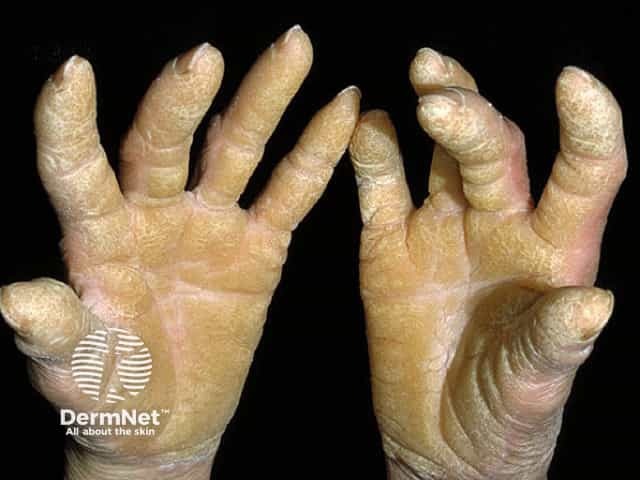
Diffuse palmoplantar keratoderma
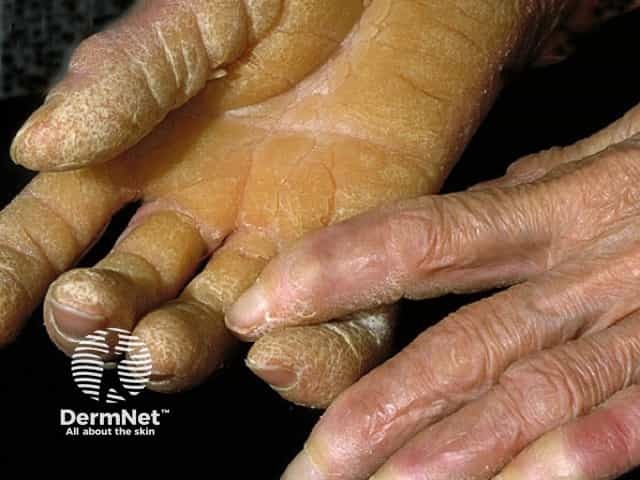
‘Transgradient’ is a term used to describe the extent of the skin thickening:
- Non-transgradient keratodermas do not extend beyond the palms on the hands and the sole on the feet. They may affect the knuckle pads and nails but do not involve the thin skin on the top of the feet or hands.
- Transgradient keratodermas extend beyond the palms and soles onto the back of the hands and feet and in some cases up the wrists and ankles. Skin around the mouth, eyes, nose, and over the elbows and knees may also be affected.
Non-transgradient diffuse hereditary palmoplantar keratodermas
The non-transgradient diffuse inherited keratodermas are known as Vorner disease (MIM 144200) and Unna-Thost disease. They are inherited as autosomal dominant conditions. There are no associated abnormalities. They look the same but have slightly different findings on skin biopsy.
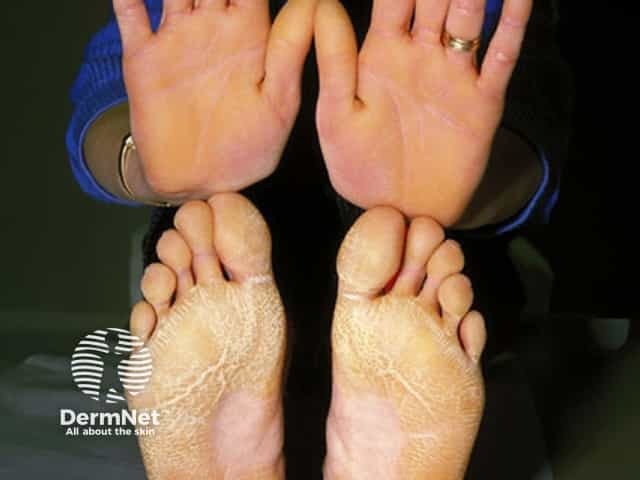
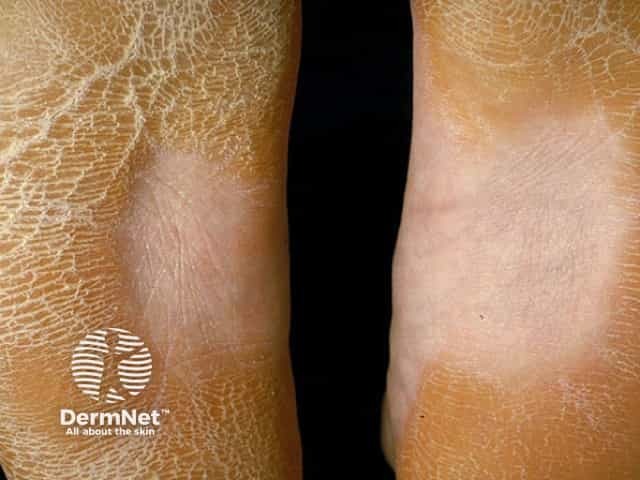
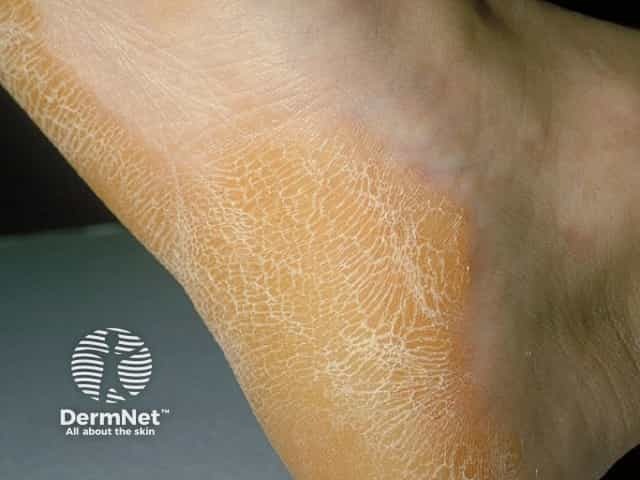
Transgradient diffuse hereditary palmoplantar keratodermas
Olmsted syndrome MIM 614594 |
|
Mal de Meleda MIM 248300 |
|
Nagashima-type MIM 615598 |
|
Huriez syndrome MIM 181600 |
|
Diffuse hereditary palmoplantar keratoderma associated with other abnormalities
Deafness
- Vohwinkel syndrome (MIM 124500) is an autosomal dominant keratoderma associated with ‘starfish’-shaped thickening over knuckles, tight bands forming around fingers which sometimes result in amputation of the finger or toe affected (pseudoainhum), and deafness.
- Loricrin keratoderma (MIM 604117) is a variant of Vohwinkel syndrome which also results in dry, scaly skin over the rest of the body (ichthyosis).
- Bart-Pumphrey syndrome (MIM 149200) is an autosomal dominant keratoderma, similar to Vohwinkel syndrome, with thickened knuckle pads, white nails and deafness.
- Mitochondrial palmoplantar keratoderma with hearing impairment is due to a mutation in mitochondria which are passed down from the mother.
Hair, nail and teeth abnormalities
- Hidrotic ectodermal dysplasia (MIM 129500) is an autosomal dominant keratoderma associated with very sparse or absent hair on the head, face and body and thickened, short nails which are easily lost. Skin thickening may also affect knuckles, knees and elbows.
- Papillon-Lefevre syndrome (MIM 245000) is an autosomal recessive keratoderma associated with inflammation of the gums and loss of teeth, sparse hair and recurrent bacterial infections of the skin and internal organs.
- Diffuse PPK with woolly hair and arrythmogenic cardiomyopathy (MIM 601214) is an autosomal recessive condition associated with congenital heart disease and coarse, unruly hair.
What is the treatment of diffuse hereditary palmoplantar keratodermas?
The following treatments soften the thickened skin and make them less noticeable.
- Emollients
- Keratolytic agents (eg, 6% salicylic acid in 70% propylene glycol)
- Topical retinoids
- Topical vitamin D ointment (calcipotriol)
- Oral retinoids (acitretin)
What is the prognosis for diffuse hereditary palmoplantar keratodermas?
Diffuse plamoplantar keratodermas persist for life and may be passed on to the next generation.
References
- OMIM – Online Mendelian Inheritance in Man (search term Diffuse hereditary palmoplantar keratodermas)
On DermNet
- Palmoplantar keratoderma (introduction)
- Hereditary focal palmoplantar keratoderma
- Punctate keratoderma
- Acquired keratoderma
- Cracked heels
Other websites
- Keratosis Palmaris et Plantaris – Medscape Reference
